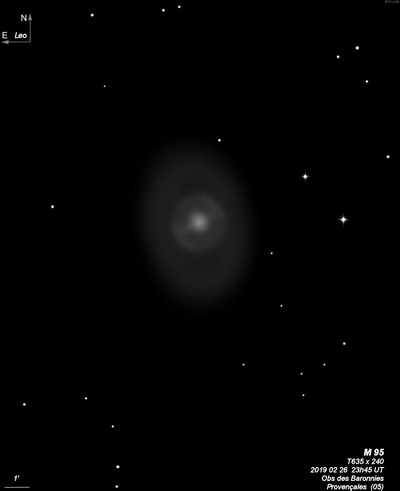
Pierre Méchain discovered M95 = H I-26 = h743 on 20 Mar 1781. WH observed M95 on 11 Mar 1784 (sweep 164) and recorded a "fine, bright nebula, much brighter in the middle than at the extremes, of a pretty considerable extent, perhaps 3 or 4' or more. The middle seems to be of the magnitude of 3 or 4 stars joined together, but not exactly round; from the brightest part of it there is a sudden transition to the nebulous part, so that I should call it cometic."
Just a week later (19 Mar 1784) he found H. I-26 and wrote, "cB, pL, not R, and much brighter about the middle than towards the ends." There is nothing at his position, but ~20' south and 1 min of RA east is M95, which was not observed in the sweep, and Dreyer concludes in his 1912 revision of H's catalogoues that H I-26 is probably a duplicate of M95.
R.J. Mitchell, observing with LdR's 72" on 16 Feb 1858, noted "I sev times thought it had two spiral arms, p and f." Sir Robert Ball commented on 10 Feb 1867, "The central bright section seems rather more complex than usual. It may be divided into two ellipses, the inner one is uniform in light and brighter than the other one." This appears to describe the core and the surrounding inner ring.
200/250mm - 8" bright, fairly large, round.
300/350mm - 13.1" (2/25/84): very bright, small bright nucleus.
400/500mm - 17.5" (2/28/87): very bright, very bright core. The outer halo is 4.5'x3.0' oriented SSW-NNE. A bar is highly suspected extending WNW-ESE of the central core with inner ring structure suspected extending from this bar. M96 (brightest in the group) lies 40' ENE.
900/1200mm - 48" (4/21/17): at 375x; extremely bright, very large, dominated by an intensely bright, round nucleus/core and a prominent central bar running nearly E-W. A strong, round ring is attached at the ends of the bar, forming a striking "Theta" shape. A well defined darker region is inside the ring to the north and south of the bar though the contrast is higher on the north side of the bar. Surrounding the ring is a very large, low surface brightness outer halo extending SSW-NNE, perhaps 5.5'-6' by 4'. With averted vision, low contrast spiral arm structure was noticed in the outer halo, particularly on the southwest side.
Notes by Steve Gottlieb